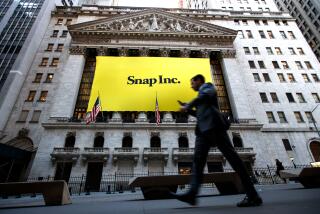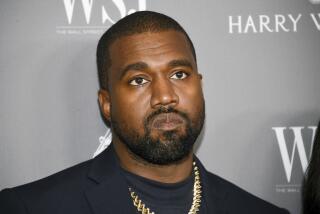Gap Earnings Beat Raised Expectations
- Share via
Gap Inc. reported positive third-quarter earnings on Thursday, indicating that the nation’s largest specialty apparel chain’s turnaround plans are gaining traction.
The San Francisco-based retailer’s earnings rose to $135 million, or 15 cents a share, in the quarter ended Nov. 2, compared with a loss of $179 million, or 21 cents a share, for the same quarter last year. It was Gap’s first quarterly year-over-year earnings increase since the first period of 2000.
A consensus of analysts from Thomson First Call had boosted its earnings expectations to 14 cents a share from 6 cents a share, after a positive report from Gap last week.
Sales rose 9% to $3.6 billion, compared with $3.3 billion in the same period last year. Sales at stores open at least a year increased 2%, compared with a 17% decrease in the comparable period the year before. It was the first quarterly comparable-store sales gain since the fourth quarter of 1999.
Gap’s stock hit a three-month high on Thursday, closing at $13.90, up 20 cents, in New York Stock Exchange trading. The earnings were released after the market closed.
While some analysts remained cautious in their assessment of the results, others said the company, parent of more than 4,200 Gap, Banana Republic and Old Navy stores, has turned a corner.
“I’m convinced [the turnaround] is already underway,” said Dorothy Lakner, an analyst with CIBC World Markets. “I think customers are beginning to return to the Gap.”
A conference call after the earnings release also gave Wall Street its first chance to hear from the company’s new chief executive, Paul Pressler, who was hired in September as the company was trying to reverse the lingering slump.
To get a feel for the company, the former Walt Disney Co. executive said he is spending his first three months on the job “listening and learning” and immersing himself in the business. He is speaking with the top 50 people at the company and visiting distribution centers. He even intends to work in one or two stores, probably over the Thanksgiving weekend.
Pressler plans to sell clothes and stock shelves, spokesman Alan Marks said. “He wants to understand all aspects of the business, particularly from the customer’s point of view,” Marks said.
Not a bad plan, Lakner said. “It probably is the best way to know the problems the people in the stores are up against,” she said. “I think that’s going to be something that should speed up his learning curve and make him much more effective as a CEO.”
Pressler, who was in charge of Disney’s theme parks and resort division, said the two companies are similar in that they have made emotional connections with their customers.
At Disney “we were storytellers,” he said. “The more I think about it, I think about this business no differently.”
That comparison drew a skeptical response from analyst Joe Teklits with Wachovia Securities. “I don’t see the emotional connection he’s talking about with the customers, and I don’t see the ability to control capital expenditures and spending and also tell a story in those stores, especially Gap stores,” he said. “I kind of view Gap stores as selling a commodity more than selling a dream.”
Ultimately, industry insiders want to see how Pressler -- who succeeded retailing icon Millard “Mickey” Drexler -- will make his mark on the company, since Pressler is known for his marketing prowess, not his fashion sense.
Ilse Metcheck, director of the California Fashion Assn., expects the company to shift “from a product-based retailer to a marketing-based retailer.”
“It remains to be seen whether the product can keep up with the razzmatazz that he will bring to the display,” she said.
Gap says it has no shortage of product expertise since the presidents of each of its brands are experienced as merchants.
The company ran into trouble after opening too many stores and stocking too-trendy merchandise in a bid to woo younger shoppers. Gap suffered a sort of identity crisis, analysts said. The company’s net income dropped from $1.1 billion in fiscal 1999 to a net loss of just less than $7.8 million in fiscal 2001.
To redefine itself, the company refocused on the basic apparel that for years had attracted shoppers to its stores, including basic jeans, khakis and classic white shirts.
That suits Quinn Breece, 20, a San Francisco resident who was shopping at Gap’s flagship store there.
“I like that you can find classic styles because most stores are trendier,” said Breece, a Trinity College student who particularly likes Gap’s jeans.
The San Francisco store is a reflection of how the company is wooing customers with basic clothes and a marketing campaign that proclaims Gap a brand “For Every Generation.” Sweaters, sweatsuits and other clothes are displayed in muted colors -- grays, blues and black. A poster leaning against one wall shows an aging Willie Nelson, the ageless Sissy Spacek, a collection of fresh-faced youths and a grandmotherly, white-haired woman wearing a sleeveless vest.
More to Read
Inside the business of entertainment
The Wide Shot brings you news, analysis and insights on everything from streaming wars to production — and what it all means for the future.
You may occasionally receive promotional content from the Los Angeles Times.










